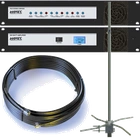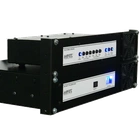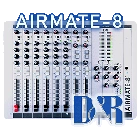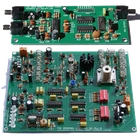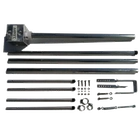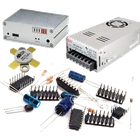1kW (1000W) FM Broadcast Transmitter User Manual
INTENDED USE
i. The various equipment in this document can only be permanently used in a predetermined location with a license or authorization from the radio spectrum regulator of your country or EU member state.
ii. The installer must have competent skills in RF engineering at their disposal, be familiar with EMC, and understand radiofrequency systems. The final installation must comply with the site engineering document at https://www.aareff.com/ETR132.pdf The radio station management must assign a responsible person for the equipment and transmission installation.
PACKAGE CHECKLIST
| Qty | Description | Item |
| 1 | Stereo Encoder Audio Limiter / 1 Watt FM Driver Exciter 15V DC (ALSCB & 1WPLLB) |  |
| 1 | 1000W FM Power Amplifier |  |
| 1 | DC to DC Cable (DC connections from ALSCB to 1WPLLB to Distribution Amplifier) |  |
| 1 | IEC AC Power Cable |  |
| 1 | MPX Audio Cable (Audio connection from ALSCB to 1WPLLB) |  |
| 1 | BNC to BNC Cable (RF connection from 1WPLLB to Distribution Amplifier to 1000WNTAP) |  |
| 1 | 15V DC Switched Mode AC Power Supply |  |
| 1 | Rack Rails |  |
USA TECHNICAL REQUIREMENTS
This transmitter includes internal audio limiting which will limit audio and in turn the maximum FM deviation. The final adjustment for this limit on maximum deviation must be made by the customer or operator, it is not something we can factory set as it depends on whether other sub carriers such as SCA or RDS or being used. The deviation, including, pilot tone and if sued RDS and SCA, should be set to maintain compliance with the FCC rules and technical requirements. More information on this is at is in section 2.1047 Modulation characteristics and section 2.1049 Occupied bandwidth at:
http://www.gpo.gov/fdsys/granule/CFR-2011-title47-vol1/CFR-2011-title47-vol1-sec2-1047/content-detail.html
EU REGULATORY REQUIREMENTS
This transmitter includes internal audio limiting which will limit audio and in turn the maximum FM deviation. The final adjustment for this limit on maximum deviation must be made by the customer or operator, it is not something we can factory set as it depends on whether other sub carriers such as SCA or RDS or being used. The deviation, including, pilot tone and if used RDS and SCA, should be set to maintain compliance with EU standards. More information on this in section 8 Audio Processing Limiter at https://www.aareff.com/ETR132.pdf
This product complies with EMC directive of the European Union. To meet this directive the user or installer must follow the wiring instructions in the this user manual
This equipment is not intended for installation by an unqualified end user, the installer must have competent RF engineering skills and EMC knowledge at their disposal. The whole transmission system, including the antenna system and external audio limiting, should be installed in the EU in accordance with document ETR132, a copy of this is available at https://www.aareff.com/ETR132.pdf
ANTENNA
 An incorrect antenna and /or bad feeder cable connections can cause RF burns and levels of RF exposure above the recommended limits for personnel
An incorrect antenna and /or bad feeder cable connections can cause RF burns and levels of RF exposure above the recommended limits for personnel
The main RF output of this unit should be connected to an antenna and feeder cable that presents 50 ohm load (SWR 1.4 or less, 16 dB or more return loss) at the operating frequency.
Ensure that all antenna connections are sound, this is important as poor connections and soldered joints can cause RF burns to personnel, severe noise to the transmission and excessive RF bandwidth. Do NOT connect the antenna to the transmitter yet.
 Under no circumstances should the unit be powered with RF OUTPUT be left open and unconnected
Under no circumstances should the unit be powered with RF OUTPUT be left open and unconnected
Ideally the antenna should be mounted at least 20 meters high and clear of any surrounding objects to get maximum range and more importantly to reduce risk of radio frequency radiation to personnel. When an antenna with 3dBi or higher gain towards the horizon is mounted at least 20 meters in height off ground and using up to 200 watts of transmitter power, power flux density measurements made at ground level directly under the antenna show less than 1 W/m2. Several European countries use a value for the power flux density of 10 W/m2 as a basis for considering whether or not an area is safe. The issue of radio frequency radiation limits is a contentious one and work in this field is continuing worldwide. Under no circumstances should an antenna be mounted and used at ground level or within a few meters of personnel.
ASSEMBLING THE TRANSMITTER
 The installation must be by an engineer that has skills and competence in EMC and radio frequency systems. The final installation should be in accordance with the site engineering document at https://www.aareff.com/ETR132.pdf
The installation must be by an engineer that has skills and competence in EMC and radio frequency systems. The final installation should be in accordance with the site engineering document at https://www.aareff.com/ETR132.pdf
1. Use the supplied M6 screws, nuts, washers, and rack rail bars to secure the Driver (1WPLLB and ALSCB) and the 1000W Amplifier together as shown in the image. The Amplifier is much heavier, so it should be at the bottom. The Driver is lightweight and should be suspended in the air without any support at the back.
Alternatively, you can mount the units in a 19-inch professional cabinet and integrate them with other equipment you have.
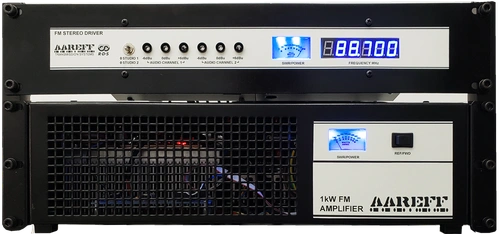
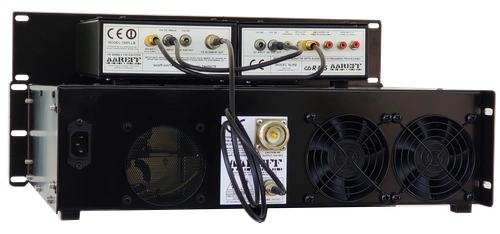
2. Connect the 1000W (1kW) RF OUTPUT of the Amplifier to 50 ohm antenna cable or dummy load
3. Using the supplied BNC to BNC cables, connect the 1 WATT RF INPUT from the Aamplifier to the 1 WATT RF OUTPUT on the Driver.
4. Using the MPX Audio cable, connect the ALSCB MPX OUTPUT to the 1WPLLB MPX INPUT on the Driver.
5. Connect the ALSCB DC AUX OUTPUT to the 1WPLLB DC INPUT using the short black DC to DC cable on the Driver
POWERING UP THE DRIVER

Plug the small 15V DC power supply into the ALSCB DC INPUT on the Driver and to the AC mains. DO NOT CONNECT THE 1000W (1kW) AMPLIFIER to the AC mains at this point
The Driver meter should illuminate RED, then after a second or so turn to BLUE. When the meter is BLUE the Driver is PLL locked on frequency. If the frequency is correct then go directly to the section POWERING UP THE AMPLIFIER
▶ If the frequency is incorrect, then go to the next section A) Setting the Frequency
▶ If the meter remains RED and does not go BLUE, then go to the next section B) Locking the PLL
Unbolt the Driver from rack rails and turn it upside down and rest it on top of the Amplifier. Do not disconnect the BNC cable from the Driver to the Amplifier and keep the Driver connected and powered to the AC. DO NOT CONNECT THE 1000W (1kW) AMPLIFIER to the AC mains at this point
You should see the following controls:
• Power Control VR2 RF PWR. ADJ
• 6 Way Dip Switches S2 and S1
• Deviation Control VR1 DEV. ADJ
• VCO Frequency Lock VC1 FREQ. ADJ
BE CAREFUL not to be too heavy handed, these controls are only small pcb mounted pots and switches and can be damaged with excessive force. You will need to use a small electrical screwdriver to adjust these controls.
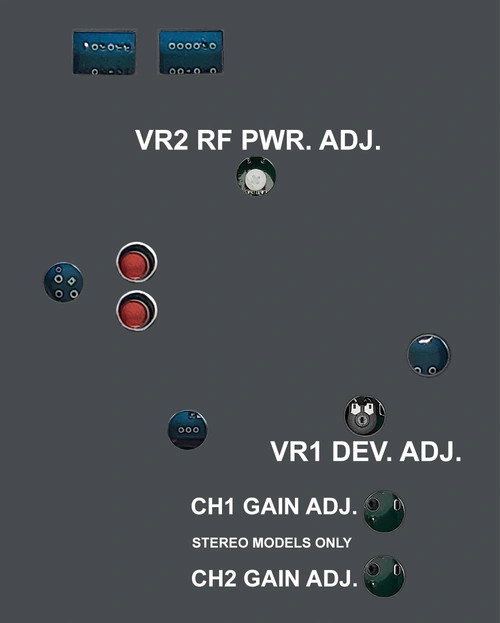
A) Setting the Frequency
Locate the two banks of 6 way dip switches S2 and S1. At the very end of this user manual you can locate the section DIL SWITCH (S2 and S1). This table shows all the frequencies from 87.5 to 108 MHz and the corresponding DIP switch settings. Look up your frequency in the table and then set the tiny dip switches to the ON or OFF position as shown in the table. These switches will determine the start up frequency for the transmitter, so, it's very important they are correct. If they are not correct it's possible to transmit on an unauthorised frequency
Double check again with the table in the Annex that the dip switches are in the correct positions. Make sure they are pushed fully into the ON position or OFF position, not halfway between.
B) Locking the PLL
It may be by chance that the PLL is close to lock and the Power Meter has lit up in BLUE. If this is not the case and the Power Meter is lit up in RED, then adjust VC1 FREQ. ADJ. SLOWLY until you get close to your desired frequency. Be patient and continue to turn slowly until the meter lights up BLUE, then STOP turning. The BLUE light indicates PLL lock. DO NOT CONNECT THE 1000W (1kW) AMPLIFIER to the AC mains at this point


C) Connecting the Audio / Baseband
In the previous section ASSEMBLING THE TRANSMITTER, the MPX Audio Lead was connected between MPX OUTPUT and the MPX INPUT. If you wish to use an external audio processor or RDS unit, it can be inserted into the MPX signal at this point.
Apply your stereo audio signal at standard line level of between -10dBu and +20dBu to the unbalanced RCA/Phono inputs AUDIO INPUT (1) and AUDIO INPUT (2). If the level is correct you should see the AUDIO CHANNEL 1/2 LEDs flashing on the front panel.
DO NOT CONNECT THE 1000W (1kW) AMPLIFIER to the AC mains at this point. You should be able to hear the Driver signal due to a very small and safe amount of signal radiation from the cables on a radio tuner within 3mt of the Driver enclosure. This is useful for checking the audio level, equalization and other qualities before actually transmitting the signal at full power on air.
D) Checking the Audio Deviation
During manufacture and test the audio deviation will be set broadcast standard line of +8dBu peak for +/-75KHz peak deviation at 88.0 MHz. There is a high possibility that this will not be the same level as the audio source feed from your studio, external audio processing device, MPX stereo generator and/or RDS generator. You need to check this as excessive deviation can cause adjacent channel interference to other users of the radio spectrum.
▶ WITHOUT TEST EQUIPMENT
Audio deviation is difficult to measure without proper test equipment and the method described here cannot replace proper test equipment, however if your regulator permits this method it is possible to check the deviation very close to correct level by using a relative comparison. Use a radio receiver tuned to a known high quality, high budget and reputed radio station. For example in the United Kingdom this would be a national BBC station. Feed the audio output of the radio receiver into some VU meter or level indication on a mixer or other audio equipment. Look carefully at the metering level peaks. You will notice the meter peak constantly at a specific level, make a note of this. Place the antenna of radio receiver as close as possible to your Driver enclosure. Re-tune the radio receiver to your frequency. Look at the metering again. Adjust VR1 DEV. ADJ. so that your audio constantly peaks at a little lower than the level you noted. When you have achieved this your deviation is a little lower or close to the legal level. The reason for this setting is that it is legal to under deviate, but not-legal to over deviate, with a lack of test equipment
 It is better to be under deviating in order to prevent adjacent channel interference until you have proper test equipment available.
It is better to be under deviating in order to prevent adjacent channel interference until you have proper test equipment available.
▶ WITH TEST EQUIPMENT
Connect the transmitter via a coupler and dummy load to a Spectrum Analyzer, Modulation Analyzer or Deviation Meter. Adjust VR2 RF PWR. to full. Adjust VR1 DEV. ADJ. for the correct deviation on the test equipment.
When you are happy and confident the audio levels are correct, reinstall the Driver the right way up in the rack above Amplifier and move to the next section POWERING UP THE AMPLIFIER
POWERING UP THE AMPLIFIER


1. IMPORTANT! A suitable 50 ohm Antenna should be connected to to the main 1kW RF OUTPUT on the Amplifier. DO NOT POWER UP THE AMPLIFER WITHOUT AN ANTENNA CONNECTED
2. The BNC to BNC cable should be connected between the 1 WATT RF INPUT from the Amplifier and the 1 WATT RF OUTPUT on the Driver.
3. The Driver should be powered, the meter showing blue and locked to frequency
If the above are confirmed, power up the Amplifier by connecting the IEC mains cable to the AC supply.
The Amplifier meter will light up blue and you will hear the cooling fans. Set the front panel switch to REF and the meter should read less than 40W.
If the meter is 40W or more, then there is a problem with the antenna, antenna cable or connectors and you should power it down and check the antenna system for faults. Then return to this setion and power up gain.
If the meter is less than 40W, then the antenna system is working fine. In this case, set the front panel switch to FWD and the meter should read close to 1000W. If this is the case, everything is working perfectly, the equipment can remain powered and you are ON AIR, permanently
 IMPORTANT!
ALWAYS KEEP FANS AND VENTILATORS CLEAN
IMPORTANT!
ALWAYS KEEP FANS AND VENTILATORS CLEAN
PROGRAMMING THE RDS

If your version of the 1kW transmitter includes RDS and you wish to change the default settings, please go to RDS Programming and User Manual
DIL SWITCH (S2 and S1)
| MHz | 1 | 2 | 3 | 4 | 5 | 6 | 1 | 2 | 3 | 4 | 5 | 6 | |
|---|---|---|---|---|---|---|---|---|---|---|---|---|---|
| 87.5 | ON | ON | OFF | OFF | ON | OFF | OFF | ON | OFF | ON | OFF | ON | |
| 87.6 | ON | ON | OFF | OFF | ON | OFF | OFF | ON | OFF | ON | OFF | OFF | |
| 87.7 | ON | ON | OFF | OFF | ON | OFF | OFF | ON | OFF | OFF | ON | ON | |
| 87.8 | ON | ON | OFF | OFF | ON | OFF | OFF | ON | OFF | OFF | ON | OFF | |
| 87.9 | ON | ON | OFF | OFF | ON | OFF | OFF | ON | OFF | OFF | OFF | ON | |
| 88 | ON | ON | OFF | OFF | ON | OFF | OFF | ON | OFF | OFF | OFF | OFF | |
| 88.1 | ON | ON | OFF | OFF | ON | OFF | OFF | OFF | ON | ON | ON | ON | |
| 88.2 | ON | ON | OFF | OFF | ON | OFF | OFF | OFF | ON | ON | ON | OFF | |
| 88.3 | ON | ON | OFF | OFF | ON | OFF | OFF | OFF | ON | ON | OFF | ON | |
| 88.4 | ON | ON | OFF | OFF | ON | OFF | OFF | OFF | ON | ON | OFF | OFF | |
| 88.5 | ON | ON | OFF | OFF | ON | OFF | OFF | OFF | ON | OFF | ON | ON | |
| 88.6 | ON | ON | OFF | OFF | ON | OFF | OFF | OFF | ON | OFF | ON | OFF | |
| 88.7 | ON | ON | OFF | OFF | ON | OFF | OFF | OFF | ON | OFF | OFF | ON | |
| 88.8 | ON | ON | OFF | OFF | ON | OFF | OFF | OFF | ON | OFF | OFF | OFF | |
| 88.9 | ON | ON | OFF | OFF | ON | OFF | OFF | OFF | OFF | ON | ON | ON | |
| 89 | ON | ON | OFF | OFF | ON | OFF | OFF | OFF | OFF | ON | ON | OFF | |
| 89.1 | ON | ON | OFF | OFF | ON | OFF | OFF | OFF | OFF | ON | OFF | ON | |
| 89.2 | ON | ON | OFF | OFF | ON | OFF | OFF | OFF | OFF | ON | OFF | OFF | |
| 89.3 | ON | ON | OFF | OFF | ON | OFF | OFF | OFF | OFF | OFF | ON | ON | |
| 89.4 | ON | ON | OFF | OFF | ON | OFF | OFF | OFF | OFF | OFF | ON | OFF | |
| 89.5 | ON | ON | OFF | OFF | ON | OFF | OFF | OFF | OFF | OFF | OFF | ON | |
| 89.6 | ON | ON | OFF | OFF | ON | OFF | OFF | OFF | OFF | OFF | OFF | OFF | |
| 89.7 | ON | ON | OFF | OFF | OFF | ON | ON | ON | ON | ON | ON | ON | |
| 89.8 | ON | ON | OFF | OFF | OFF | ON | ON | ON | ON | ON | ON | OFF | |
| 89.9 | ON | ON | OFF | OFF | OFF | ON | ON | ON | ON | ON | OFF | ON | |
| 90 | ON | ON | OFF | OFF | OFF | ON | ON | ON | ON | ON | OFF | OFF | |
| 90.1 | ON | ON | OFF | OFF | OFF | ON | ON | ON | ON | OFF | ON | ON | |
| 90.2 | ON | ON | OFF | OFF | OFF | ON | ON | ON | ON | OFF | ON | OFF | |
| 90.3 | ON | ON | OFF | OFF | OFF | ON | ON | ON | ON | OFF | OFF | ON | |
| 90.4 | ON | ON | OFF | OFF | OFF | ON | ON | ON | ON | OFF | OFF | OFF | |
| 90.5 | ON | ON | OFF | OFF | OFF | ON | ON | ON | OFF | ON | ON | ON | |
| 90.6 | ON | ON | OFF | OFF | OFF | ON | ON | ON | OFF | ON | ON | OFF | |
| 90.7 | ON | ON | OFF | OFF | OFF | ON | ON | ON | OFF | ON | OFF | ON | |
| 90.8 | ON | ON | OFF | OFF | OFF | ON | ON | ON | OFF | ON | OFF | OFF | |
| 90.9 | ON | ON | OFF | OFF | OFF | ON | ON | ON | OFF | OFF | ON | ON | |
| 91 | ON | ON | OFF | OFF | OFF | ON | ON | ON | OFF | OFF | ON | OFF | |
| 91.1 | ON | ON | OFF | OFF | OFF | ON | ON | ON | OFF | OFF | OFF | ON | |
| 91.2 | ON | ON | OFF | OFF | OFF | ON | ON | ON | OFF | OFF | OFF | OFF | |
| 91.3 | ON | ON | OFF | OFF | OFF | ON | ON | OFF | ON | ON | ON | ON | |
| 91.4 | ON | ON | OFF | OFF | OFF | ON | ON | OFF | ON | ON | ON | OFF | |
| 91.5 | ON | ON | OFF | OFF | OFF | ON | ON | OFF | ON | ON | OFF | ON | |
| 91.6 | ON | ON | OFF | OFF | OFF | ON | ON | OFF | ON | ON | OFF | OFF | |
| 91.7 | ON | ON | OFF | OFF | OFF | ON | ON | OFF | ON | OFF | ON | ON | |
| 91.8 | ON | ON | OFF | OFF | OFF | ON | ON | OFF | ON | OFF | ON | OFF | |
| 91.9 | ON | ON | OFF | OFF | OFF | ON | ON | OFF | ON | OFF | OFF | ON | |
| 92 | ON | ON | OFF | OFF | OFF | ON | ON | OFF | ON | OFF | OFF | OFF | |
| 92.1 | ON | ON | OFF | OFF | OFF | ON | ON | OFF | OFF | ON | ON | ON | |
| 92.2 | ON | ON | OFF | OFF | OFF | ON | ON | OFF | OFF | ON | ON | OFF | |
| 92.3 | ON | ON | OFF | OFF | OFF | ON | ON | OFF | OFF | ON | OFF | ON | |
| 92.4 | ON | ON | OFF | OFF | OFF | ON | ON | OFF | OFF | ON | OFF | OFF | |
| 92.5 | ON | ON | OFF | OFF | OFF | ON | ON | OFF | OFF | OFF | ON | ON | |
| 92.6 | ON | ON | OFF | OFF | OFF | ON | ON | OFF | OFF | OFF | ON | OFF | |
| 92.7 | ON | ON | OFF | OFF | OFF | ON | ON | OFF | OFF | OFF | OFF | ON | |
| 92.8 | ON | ON | OFF | OFF | OFF | ON | ON | OFF | OFF | OFF | OFF | OFF | |
| 92.9 | ON | ON | OFF | OFF | OFF | ON | OFF | ON | ON | ON | ON | ON | |
| 93 | ON | ON | OFF | OFF | OFF | ON | OFF | ON | ON | ON | ON | OFF | |
| 93.1 | ON | ON | OFF | OFF | OFF | ON | OFF | ON | ON | ON | OFF | ON | |
| 93.2 | ON | ON | OFF | OFF | OFF | ON | OFF | ON | ON | ON | OFF | OFF | |
| 93.3 | ON | ON | OFF | OFF | OFF | ON | OFF | ON | ON | OFF | ON | ON | |
| 93.4 | ON | ON | OFF | OFF | OFF | ON | OFF | ON | ON | OFF | ON | OFF | |
| 93.5 | ON | ON | OFF | OFF | OFF | ON | OFF | ON | ON | OFF | OFF | ON | |
| 93.6 | ON | ON | OFF | OFF | OFF | ON | OFF | ON | ON | OFF | OFF | OFF | |
| 93.7 | ON | ON | OFF | OFF | OFF | ON | OFF | ON | OFF | ON | ON | ON | |
| 93.8 | ON | ON | OFF | OFF | OFF | ON | OFF | ON | OFF | ON | ON | OFF | |
| 93.9 | ON | ON | OFF | OFF | OFF | ON | OFF | ON | OFF | ON | OFF | ON | |
| 94 | ON | ON | OFF | OFF | OFF | ON | OFF | ON | OFF | ON | OFF | OFF | |
| 94.1 | ON | ON | OFF | OFF | OFF | ON | OFF | ON | OFF | OFF | ON | ON | |
| 94.2 | ON | ON | OFF | OFF | OFF | ON | OFF | ON | OFF | OFF | ON | OFF | |
| 94.3 | ON | ON | OFF | OFF | OFF | ON | OFF | ON | OFF | OFF | OFF | ON | |
| 94.4 | ON | ON | OFF | OFF | OFF | ON | OFF | ON | OFF | OFF | OFF | OFF | |
| 94.5 | ON | ON | OFF | OFF | OFF | ON | OFF | OFF | ON | ON | ON | ON | |
| 94.6 | ON | ON | OFF | OFF | OFF | ON | OFF | OFF | ON | ON | ON | OFF | |
| 94.7 | ON | ON | OFF | OFF | OFF | ON | OFF | OFF | ON | ON | OFF | ON | |
| 94.8 | ON | ON | OFF | OFF | OFF | ON | OFF | OFF | ON | ON | OFF | OFF | |
| 94.9 | ON | ON | OFF | OFF | OFF | ON | OFF | OFF | ON | OFF | ON | ON | |
| 95 | ON | ON | OFF | OFF | OFF | ON | OFF | OFF | ON | OFF | ON | OFF | |
| 95.1 | ON | ON | OFF | OFF | OFF | ON | OFF | OFF | ON | OFF | OFF | ON | |
| 95.2 | ON | ON | OFF | OFF | OFF | ON | OFF | OFF | ON | OFF | OFF | OFF | |
| 95.3 | ON | ON | OFF | OFF | OFF | ON | OFF | OFF | OFF | ON | ON | ON | |
| 95.4 | ON | ON | OFF | OFF | OFF | ON | OFF | OFF | OFF | ON | ON | OFF | |
| 95.5 | ON | ON | OFF | OFF | OFF | ON | OFF | OFF | OFF | ON | OFF | ON | |
| 95.6 | ON | ON | OFF | OFF | OFF | ON | OFF | OFF | OFF | ON | OFF | OFF | |
| 95.7 | ON | ON | OFF | OFF | OFF | ON | OFF | OFF | OFF | OFF | ON | ON | |
| 95.8 | ON | ON | OFF | OFF | OFF | ON | OFF | OFF | OFF | OFF | ON | OFF | |
| 95.9 | ON | ON | OFF | OFF | OFF | ON | OFF | OFF | OFF | OFF | OFF | ON | |
| 96 | ON | ON | OFF | OFF | OFF | ON | OFF | OFF | OFF | OFF | OFF | OFF | |
| 96.1 | ON | ON | OFF | OFF | OFF | OFF | ON | ON | ON | ON | ON | ON | |
| 96.2 | ON | ON | OFF | OFF | OFF | OFF | ON | ON | ON | ON | ON | OFF | |
| 96.3 | ON | ON | OFF | OFF | OFF | OFF | ON | ON | ON | ON | OFF | ON | |
| 96.4 | ON | ON | OFF | OFF | OFF | OFF | ON | ON | ON | ON | OFF | OFF | |
| 96.5 | ON | ON | OFF | OFF | OFF | OFF | ON | ON | ON | OFF | ON | ON | |
| 96.6 | ON | ON | OFF | OFF | OFF | OFF | ON | ON | ON | OFF | ON | OFF | |
| 96.7 | ON | ON | OFF | OFF | OFF | OFF | ON | ON | ON | OFF | OFF | ON | |
| 96.8 | ON | ON | OFF | OFF | OFF | OFF | ON | ON | ON | OFF | OFF | OFF | |
| 96.9 | ON | ON | OFF | OFF | OFF | OFF | ON | ON | OFF | ON | ON | ON | |
| 97 | ON | ON | OFF | OFF | OFF | OFF | ON | ON | OFF | ON | ON | OFF | |
| 97.1 | ON | ON | OFF | OFF | OFF | OFF | ON | ON | OFF | ON | OFF | ON | |
| 97.2 | ON | ON | OFF | OFF | OFF | OFF | ON | ON | OFF | ON | OFF | OFF | |
| 97.3 | ON | ON | OFF | OFF | OFF | OFF | ON | ON | OFF | OFF | ON | ON | |
| 97.4 | ON | ON | OFF | OFF | OFF | OFF | ON | ON | OFF | OFF | ON | OFF | |
| 97.5 | ON | ON | OFF | OFF | OFF | OFF | ON | ON | OFF | OFF | OFF | ON | |
| 97.6 | ON | ON | OFF | OFF | OFF | OFF | ON | ON | OFF | OFF | OFF | OFF | |
| 97.7 | ON | ON | OFF | OFF | OFF | OFF | ON | OFF | ON | ON | ON | ON | |
| 97.8 | ON | ON | OFF | OFF | OFF | OFF | ON | OFF | ON | ON | ON | OFF | |
| 97.9 | ON | ON | OFF | OFF | OFF | OFF | ON | OFF | ON | ON | OFF | ON | |
| 98 | ON | ON | OFF | OFF | OFF | OFF | ON | OFF | ON | ON | OFF | OFF | |
| 98.1 | ON | ON | OFF | OFF | OFF | OFF | ON | OFF | ON | OFF | ON | ON | |
| 98.2 | ON | ON | OFF | OFF | OFF | OFF | ON | OFF | ON | OFF | ON | OFF | |
| 98.3 | ON | ON | OFF | OFF | OFF | OFF | ON | OFF | ON | OFF | OFF | ON | |
| 98.4 | ON | ON | OFF | OFF | OFF | OFF | ON | OFF | ON | OFF | OFF | OFF | |
| 98.5 | ON | ON | OFF | OFF | OFF | OFF | ON | OFF | OFF | ON | ON | ON | |
| 98.6 | ON | ON | OFF | OFF | OFF | OFF | ON | OFF | OFF | ON | ON | OFF | |
| 98.7 | ON | ON | OFF | OFF | OFF | OFF | ON | OFF | OFF | ON | OFF | ON | |
| 98.8 | ON | ON | OFF | OFF | OFF | OFF | ON | OFF | OFF | ON | OFF | OFF | |
| 98.9 | ON | ON | OFF | OFF | OFF | OFF | ON | OFF | OFF | OFF | ON | ON | |
| 99 | ON | ON | OFF | OFF | OFF | OFF | ON | OFF | OFF | OFF | ON | OFF | |
| 99.1 | ON | ON | OFF | OFF | OFF | OFF | ON | OFF | OFF | OFF | OFF | ON | |
| 99.2 | ON | ON | OFF | OFF | OFF | OFF | ON | OFF | OFF | OFF | OFF | OFF | |
| 99.3 | ON | ON | OFF | OFF | OFF | OFF | OFF | ON | ON | ON | ON | ON | |
| 99.4 | ON | ON | OFF | OFF | OFF | OFF | OFF | ON | ON | ON | ON | OFF | |
| 99.5 | ON | ON | OFF | OFF | OFF | OFF | OFF | ON | ON | ON | OFF | ON | |
| 99.6 | ON | ON | OFF | OFF | OFF | OFF | OFF | ON | ON | ON | OFF | OFF | |
| 99.7 | ON | ON | OFF | OFF | OFF | OFF | OFF | ON | ON | OFF | ON | ON | |
| 99.8 | ON | ON | OFF | OFF | OFF | OFF | OFF | ON | ON | OFF | ON | OFF | |
| 99.9 | ON | ON | OFF | OFF | OFF | OFF | OFF | ON | ON | OFF | OFF | ON | |
| 100 | ON | ON | OFF | OFF | OFF | OFF | OFF | ON | ON | OFF | OFF | OFF | |
| 100.1 | ON | ON | OFF | OFF | OFF | OFF | OFF | ON | OFF | ON | ON | ON | |
| 100.2 | ON | ON | OFF | OFF | OFF | OFF | OFF | ON | OFF | ON | ON | OFF | |
| 100.3 | ON | ON | OFF | OFF | OFF | OFF | OFF | ON | OFF | ON | OFF | ON | |
| 100.4 | ON | ON | OFF | OFF | OFF | OFF | OFF | ON | OFF | ON | OFF | OFF | |
| 100.5 | ON | ON | OFF | OFF | OFF | OFF | OFF | ON | OFF | OFF | ON | ON | |
| 100.6 | ON | ON | OFF | OFF | OFF | OFF | OFF | ON | OFF | OFF | ON | OFF | |
| 100.7 | ON | ON | OFF | OFF | OFF | OFF | OFF | ON | OFF | OFF | OFF | ON | |
| 100.8 | ON | ON | OFF | OFF | OFF | OFF | OFF | ON | OFF | OFF | OFF | OFF | |
| 100.9 | ON | ON | OFF | OFF | OFF | OFF | OFF | OFF | ON | ON | ON | ON | |
| 101 | ON | ON | OFF | OFF | OFF | OFF | OFF | OFF | ON | ON | ON | OFF | |
| 101.1 | ON | ON | OFF | OFF | OFF | OFF | OFF | OFF | ON | ON | OFF | ON | |
| 101.2 | ON | ON | OFF | OFF | OFF | OFF | OFF | OFF | ON | ON | OFF | OFF | |
| 101.3 | ON | ON | OFF | OFF | OFF | OFF | OFF | OFF | ON | OFF | ON | ON | |
| 101.4 | ON | ON | OFF | OFF | OFF | OFF | OFF | OFF | ON | OFF | ON | OFF | |
| 101.5 | ON | ON | OFF | OFF | OFF | OFF | OFF | OFF | ON | OFF | OFF | ON | |
| 101.6 | ON | ON | OFF | OFF | OFF | OFF | OFF | OFF | ON | OFF | OFF | OFF | |
| 101.7 | ON | ON | OFF | OFF | OFF | OFF | OFF | OFF | OFF | ON | ON | ON | |
| 101.8 | ON | ON | OFF | OFF | OFF | OFF | OFF | OFF | OFF | ON | ON | OFF | |
| 101.9 | ON | ON | OFF | OFF | OFF | OFF | OFF | OFF | OFF | ON | OFF | ON | |
| 102 | ON | ON | OFF | OFF | OFF | OFF | OFF | OFF | OFF | ON | OFF | OFF | |
| 102.1 | ON | ON | OFF | OFF | OFF | OFF | OFF | OFF | OFF | OFF | ON | ON | |
| 102.2 | ON | ON | OFF | OFF | OFF | OFF | OFF | OFF | OFF | OFF | ON | OFF | |
| 102.3 | ON | ON | OFF | OFF | OFF | OFF | OFF | OFF | OFF | OFF | OFF | ON | |
| 102.4 | ON | ON | OFF | OFF | OFF | OFF | OFF | OFF | OFF | OFF | OFF | OFF | |
| 102.5 | ON | OFF | ON | ON | ON | ON | ON | ON | ON | ON | ON | ON | |
| 102.6 | ON | OFF | ON | ON | ON | ON | ON | ON | ON | ON | ON | OFF | |
| 102.7 | ON | OFF | ON | ON | ON | ON | ON | ON | ON | ON | OFF | ON | |
| 102.8 | ON | OFF | ON | ON | ON | ON | ON | ON | ON | ON | OFF | OFF | |
| 102.9 | ON | OFF | ON | ON | ON | ON | ON | ON | ON | OFF | ON | ON | |
| 103 | ON | OFF | ON | ON | ON | ON | ON | ON | ON | OFF | ON | OFF | |
| 103.1 | ON | OFF | ON | ON | ON | ON | ON | ON | ON | OFF | OFF | ON | |
| 103.2 | ON | OFF | ON | ON | ON | ON | ON | ON | ON | OFF | OFF | OFF | |
| 103.3 | ON | OFF | ON | ON | ON | ON | ON | ON | OFF | ON | ON | ON | |
| 103.4 | ON | OFF | ON | ON | ON | ON | ON | ON | OFF | ON | ON | OFF | |
| 103.5 | ON | OFF | ON | ON | ON | ON | ON | ON | OFF | ON | OFF | ON | |
| 103.6 | ON | OFF | ON | ON | ON | ON | ON | ON | OFF | ON | OFF | OFF | |
| 103.7 | ON | OFF | ON | ON | ON | ON | ON | ON | OFF | OFF | ON | ON | |
| 103.8 | ON | OFF | ON | ON | ON | ON | ON | ON | OFF | OFF | ON | OFF | |
| 103.9 | ON | OFF | ON | ON | ON | ON | ON | ON | OFF | OFF | OFF | ON | |
| 104 | ON | OFF | ON | ON | ON | ON | ON | ON | OFF | OFF | OFF | OFF | |
| 104.1 | ON | OFF | ON | ON | ON | ON | ON | OFF | ON | ON | ON | ON | |
| 104.2 | ON | OFF | ON | ON | ON | ON | ON | OFF | ON | ON | ON | OFF | |
| 104.3 | ON | OFF | ON | ON | ON | ON | ON | OFF | ON | ON | OFF | ON | |
| 104.4 | ON | OFF | ON | ON | ON | ON | ON | OFF | ON | ON | OFF | OFF | |
| 104.5 | ON | OFF | ON | ON | ON | ON | ON | OFF | ON | OFF | ON | ON | |
| 104.6 | ON | OFF | ON | ON | ON | ON | ON | OFF | ON | OFF | ON | OFF | |
| 104.7 | ON | OFF | ON | ON | ON | ON | ON | OFF | ON | OFF | OFF | ON | |
| 104.8 | ON | OFF | ON | ON | ON | ON | ON | OFF | ON | OFF | OFF | OFF | |
| 104.9 | ON | OFF | ON | ON | ON | ON | ON | OFF | OFF | ON | ON | ON | |
| 105 | ON | OFF | ON | ON | ON | ON | ON | OFF | OFF | ON | ON | OFF | |
| 105.1 | ON | OFF | ON | ON | ON | ON | ON | OFF | OFF | ON | OFF | ON | |
| 105.2 | ON | OFF | ON | ON | ON | ON | ON | OFF | OFF | ON | OFF | OFF | |
| 105.3 | ON | OFF | ON | ON | ON | ON | ON | OFF | OFF | OFF | ON | ON | |
| 105.4 | ON | OFF | ON | ON | ON | ON | ON | OFF | OFF | OFF | ON | OFF | |
| 105.5 | ON | OFF | ON | ON | ON | ON | ON | OFF | OFF | OFF | OFF | ON | |
| 105.6 | ON | OFF | ON | ON | ON | ON | ON | OFF | OFF | OFF | OFF | OFF | |
| 105.7 | ON | OFF | ON | ON | ON | ON | OFF | ON | ON | ON | ON | ON | |
| 105.8 | ON | OFF | ON | ON | ON | ON | OFF | ON | ON | ON | ON | OFF | |
| 105.9 | ON | OFF | ON | ON | ON | ON | OFF | ON | ON | ON | OFF | ON | |
| 106 | ON | OFF | ON | ON | ON | ON | OFF | ON | ON | ON | OFF | OFF | |
| 106.1 | ON | OFF | ON | ON | ON | ON | OFF | ON | ON | OFF | ON | ON | |
| 106.2 | ON | OFF | ON | ON | ON | ON | OFF | ON | ON | OFF | ON | OFF | |
| 106.3 | ON | OFF | ON | ON | ON | ON | OFF | ON | ON | OFF | OFF | ON | |
| 106.4 | ON | OFF | ON | ON | ON | ON | OFF | ON | ON | OFF | OFF | OFF | |
| 106.5 | ON | OFF | ON | ON | ON | ON | OFF | ON | OFF | ON | ON | ON | |
| 106.6 | ON | OFF | ON | ON | ON | ON | OFF | ON | OFF | ON | ON | OFF | |
| 106.7 | ON | OFF | ON | ON | ON | ON | OFF | ON | OFF | ON | OFF | ON | |
| 106.8 | ON | OFF | ON | ON | ON | ON | OFF | ON | OFF | ON | OFF | OFF | |
| 106.9 | ON | OFF | ON | ON | ON | ON | OFF | ON | OFF | OFF | ON | ON | |
| 107 | ON | OFF | ON | ON | ON | ON | OFF | ON | OFF | OFF | ON | OFF | |
| 107.1 | ON | OFF | ON | ON | ON | ON | OFF | ON | OFF | OFF | OFF | ON | |
| 107.2 | ON | OFF | ON | ON | ON | ON | OFF | ON | OFF | OFF | OFF | OFF | |
| 107.3 | ON | OFF | ON | ON | ON | ON | OFF | OFF | ON | ON | ON | ON | |
| 107.4 | ON | OFF | ON | ON | ON | ON | OFF | OFF | ON | ON | ON | OFF | |
| 107.5 | ON | OFF | ON | ON | ON | ON | OFF | OFF | ON | ON | OFF | ON | |
| 107.6 | ON | OFF | ON | ON | ON | ON | OFF | OFF | ON | ON | OFF | OFF | |
| 107.7 | ON | OFF | ON | ON | ON | ON | OFF | OFF | ON | OFF | ON | ON | |
| 107.8 | ON | OFF | ON | ON | ON | ON | OFF | OFF | ON | OFF | ON | OFF | |
| 107.9 | ON | OFF | ON | ON | ON | ON | OFF | OFF | ON | OFF | OFF | ON | |
| 108 | ON | OFF | ON | ON | ON | ON | OFF | OFF | ON | OFF | OFF | OFF |
DRIVER FRONT PANEL

| 1 | Transmitter Model |
| 2 | Manufacturer |
| 3 | Power Indicator |
| 4a | Ch1 Audio Input -6dBu AGC Onset |
| 4b | Ch1 Audio Input -6dBu Limiting Onset |
| 4c | Ch1 Audio Input -6dBu Hard Limiting |
| 5a | Ch2 Audio Input -6dBu AGC Onset |
| 5b | Ch2 Audio Input -6dBu Limiting Onset |
| 5c | Ch2 Audio Input -6dBu Hard Limiting |
| 6 | Power Meter and Lock Indication (RED unlocked, BLUE locked) |
| 7 | Frequency Counter |
DRIVER BACK PANEL

MAINTENANCE
The only maintenance the amplifier needs is some periodic cleaning. Following a number of weeks of continuous 24/7 use (specified below), the transmitter should be shut down and disconnected. A technician or engineer needs to take of the top lid by removing the self tapper screws. Using a soft new and clean paint brush with a vacuum clean hose, the dust should be gently brushed and sucked away from all areas inside. Pay particular attention to the actual fans at the rear and the fan vent at front.
The table below shows the recommended number of weeks cleaning should be done for some typical environmental areas.
| WEEKS | SALTY | SANDY | DUSTY | PUBLIC | CLEAN |
| 4 |  |
||||
| 6 |  |
 |
|||
| 8 |  |
||||
| 12 |  |
 Do not adjust any factory set internal controls.
Do not adjust any factory set internal controls.
Under NO CIRCUMSTANCES should any adjustments be made to the internal controls. Such adjustments could damage the unit and invalidate the warranty and also cause serious interference to other users of the electromagnetic spectrum.
LEGAL ADVICE
We sell this equipment to professionals and organizations in good faith it will be used correctly and legally. Nearly every country in the world require licensing for this type of equipment. It is the customer’s responsibility to check relevant laws, directives, regulations and licensing requirements before installing or putting this product into service with an antenna system. You, the customer or user agree to defend, indemnify and hold harmless Aareff Systems Limited, it’s employees and agents, from and against any claims, actions or demands, including without limitation legal and accounting fees, alleging or resulting from improper or unlawful use of this equipment.
TECHNICAL DATA
(All stated measurements were made at 220VAC at 26 Degrees Celsius ambient temperature unless stated)
RF and AF Parameters
| Power Output Adj. | 10-1000 Watts into 50 ohms |
| Freq Range | 87.5 to 108 MHz |
| Spurious Emissions | Less than -75 dB ref to carrier |
| Harmonic Emissions | Less than -70 dB ref to carrier |
| Out of Lock RF Muting | Less than -70 dB ref to carrier |
| Freq Stability | Less than +/- 2 KHz between -20 and +40 C |
| Freq Fine | Adj +/- 1000 Hz |
| Freq Adj. Accuracy | +/- 50 Hz |
| Deviation Sensitivity Stability | +/-2 % max |
| Residual AM | Less than 0.5 % |
| Synchronous AM | Less than 0.5 % |
| RF Output Connector | DIN 7-16 |
| RF Ruggedness | Any VSWR, phase, length of time |
| MPX Audio Input | Connector Phono/ RCA type unbalanced |
| Pre-emphasis | (50uS/ 75uS/ None) |
| MPX Audio Input Sensitivity | Nom. 0.775 V rms for +/- 75 KHz Dev. User adj. |
| MPX Signal To Noise Ratio | More than 72 dB rel. +/-75KHz dev. |
| MPX Audio Freq Response | Less than +/-0.5dB between 30 Hz and 76 KHz |
| MPX Audio Distortion | Less than 0.2 % THD |
| Operating Temp | -20 to +40 Deg C |
AC Mains Parameters
| Input Voltage | 90-260V AC 47-63 Hz |
| Input Power | 1500W for 1000W RF OUT with RF SWR less than 1.5 |
| Power Factor | PF>0.95/230VAC PF>0.98/115VAC at full power |
| Working Humidity | 20 ~ 90% RH non-condensing |
| Safety Standards | UL60950-1, TUV EN60950-1 Approved |
| EMC Conduction & Radiation | Compliance to EN55022 (CISPR22) Class B |
| EMC Harmonic Current | Compliance to EN61000-3-2,-3 |
| EMC Immunity | Compliance to EN61000-4-2,3,4,5,6,8,11; ENV50204, Light industry level, criteria A |
EQUIPMENT COMPLIANCE (DECLARATION OF CONFORMITY)
European Union
We hereby declare that this equipment complies with;
• ETS 300384 European Telecommunications Harmonised Standard when used with an audio compressor limiter supplied and tested by Aareff
• EN 301489-11 V1.3.1 (2006-05) EMC Electromagnetic Compatibility when used with 1 meter AC mains cord supplied. If the installation engineer needs to extend this cord, this and the audio input cable should be no more than 3 meters in length to remain in compliance with EMC directive.
• 2006/95/EC Directive (2006-12) LVD Low Voltage Directive.
Equipment compliance is possible using equipment from and in conjunction from other manufacturers, but since this is beyond the control of Aareff Systems, Aareff Systems cannot or be expected to guarantee compliance in this situation.
United States
This equipment has not been independently tested by an FCC recognised listed laboratory and for this reason it is not certified. The following list are the technical requirements for the certification of this transmitter. We hereby declare and verify that this transmitter complies with the following FCC technical requirements.
47 CFR Chapter I Federal Communications Commission sections:
• 73.1560, 2.1046 RF Power
• 73.1545, 2.1055 Frequency Stability
• 73.317, 2.1049 (e)(3) Emission Limitation, Emission Mask
• 73.317, 2.1057, 2.1051 Emission Limits, Spurious Emissions at Antenna Terminal
• 73.317, 2.1057, 2.1053 Emission Limits, Field Strength of Spurious Emissions
ROHS
All components used in this apparatus are RoHS compliant and do not contain above the specified limits in any of the following restricted substances:
• Lead
• Hexavalent Chromium
• Mercury
• Cadmium
• Polybrominated Biphenyls (PBB's)
• Polybrominated Diphenylethers (PBDE's)
PRODUCT END OF LIFE
This apparatus must NOT be disposed of with other domestic waste.

 +1 829 698 0733
What Do You Need? Talk To Us
+1 829 698 0733
What Do You Need? Talk To Us
